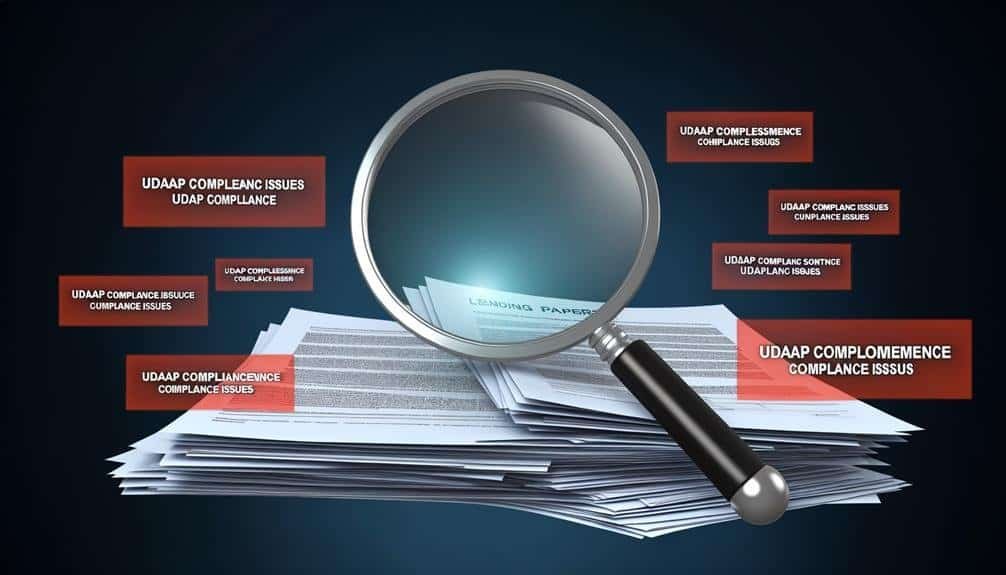What Falls Under Higher Risk for UDAAP Compliance?
Are you aware of the potential risks that your organization may face when it comes to UDAAP compliance? Certain practices can put you at higher risk, but do you know which ones?
In this discussion, we will explore the areas that fall under higher risk for UDAAP compliance, including misleading advertising practices, deceptive fee structures, inadequate customer disclosure, unfair debt collection practices, and non-compliant product disclosures.
By understanding these risks, you will be better equipped to ensure compliance and protect your organization. So, let's dive in and uncover the potential pitfalls that could be lurking within your operations.
Key Takeaways
- Misleading advertising practices, such as false claims and ambiguous statements, pose a higher risk for UDAAP compliance.
- Deceptive fee structures, including hidden charges and misleading pricing, can result in UDAAP violations and financial harm to consumers.
- Inadequate customer disclosure, such as insufficient transparency and hidden terms and conditions, increases the risk of UDAAP non-compliance and financial harm to customers.
- Unfair debt collection practices, such as improper communication and unauthorized disclosure of personal information, can lead to UDAAP violations and legal consequences.
Misleading Advertising Practices
Misleading advertising practices pose a higher risk for UDAAP compliance. False claims and ambiguous statements are two common tactics used in misleading advertisements.
False claims involve making statements that aren't supported by evidence or are intentionally deceptive. These can include promises of quick results or exaggerated benefits of a product or service.
Ambiguous statements, on the other hand, are intentionally vague and open to interpretation. They can mislead consumers by not providing clear and accurate information about the product or service being advertised.
Both false claims and ambiguous statements can lead to UDAAP violations as they deceive consumers and can result in financial harm.
To ensure UDAAP compliance, businesses must be cautious in their advertising practices and provide accurate and transparent information to consumers.
Deceptive Fee Structures
When it comes to UDAAP compliance, another area of concern is the presence of deceptive fee structures that can potentially harm consumers financially. To ensure transparency and protect consumers, it's crucial for businesses to avoid hidden charges and misleading pricing.
Here are three key aspects to consider:
- Clearly disclose all fees: Transparently communicate any charges associated with products or services to avoid surprises for customers.
- Accurate pricing information: Provide accurate and detailed pricing information to prevent customers from being deceived by misleading prices.
- Consistency in fee structures: Maintain consistency in fee structures to avoid confusion and ensure fairness in pricing.
Inadequate Customer Disclosure
Customers must be provided with adequate disclosure of information to ensure transparency and protect their financial well-being. However, some financial institutions fail to provide sufficient transparency, leaving customers unaware of hidden terms and conditions that may negatively impact their financial situation.
Insufficient transparency occurs when important information is intentionally concealed or buried within complex documents. This lack of disclosure can lead to misunderstandings, confusion, and ultimately harm the customer. Hidden terms, such as high fees or penalties, can have significant financial consequences for the customer, impacting their ability to manage their finances effectively.
To avoid falling into the trap of inadequate customer disclosure, financial institutions must prioritize clear and concise communication, ensuring that all terms and conditions are easily accessible and understandable for their customers.
Unfair Debt Collection Practices
Financial institutions must adhere to fair and ethical practices when collecting debts to protect the rights and well-being of consumers. Unfair debt collection practices can lead to harassment complaints and legal consequences. To ensure compliance, consider the following:
- Proper Communication: Communicate with debtors respectfully and avoid using abusive or threatening language.
- Accuracy of Information: Ensure that all information provided to debtors is accurate and not misleading.
- Privacy Protection: Safeguard the personal information of debtors and avoid disclosing it to unauthorized parties.
Harassment complaints can result in reputational damage and costly legal battles. Moreover, violating debt collection laws can lead to penalties, fines, and even suspension of collection activities. It's crucial for financial institutions to prioritize fair and ethical practices to avoid these negative outcomes.
Non-Compliant Product Disclosures
Product disclosures that don't comply with regulatory requirements can result in legal and reputational risks for financial institutions. Incomplete information and hidden charges are two common issues that can make product disclosures non-compliant.
When financial institutions fail to provide complete and accurate information about their products, it can mislead consumers and result in negative consequences. For example, if a bank fails to disclose all the fees associated with a credit card, customers may be surprised by unexpected charges, leading to dissatisfaction and potential legal action.
Similarly, hiding charges or burying them in fine print can also be considered non-compliant, as it prevents consumers from making informed decisions.
To avoid these risks, financial institutions must ensure that their product disclosures are transparent, comprehensive, and comply with all relevant regulations.
Conclusion
After thoroughly investigating the factors that fall under higher risk for UDAAP compliance, it's clear that misleading advertising practices, deceptive fee structures, inadequate customer disclosure, unfair debt collection practices, and non-compliant product disclosures pose significant risks.
To ensure compliance, it's crucial for companies to diligently address these areas and prioritize transparency and fairness in their business practices. By doing so, they can protect consumers and maintain a high level of integrity and trust in the marketplace.







